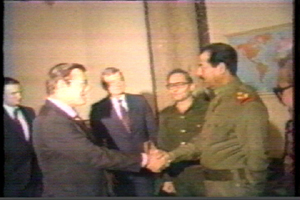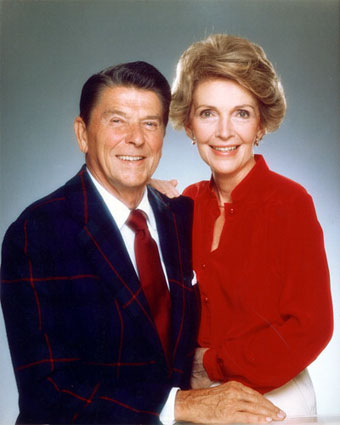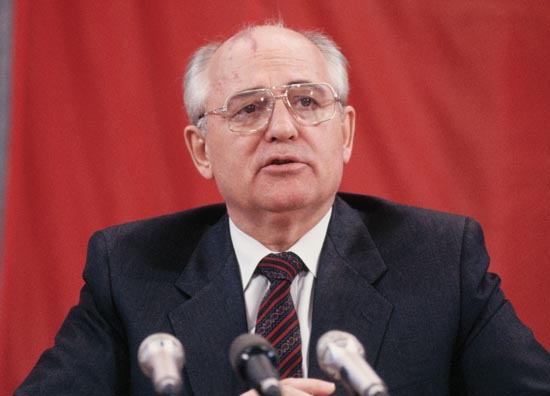A. Aging Soviet Leadership—One of the concerns about Ronald Reagan was his advance aged when he was elected—but he was younger than either of the two Soviet Union premiers who held office in Reagan’s first term in office
B. The Soviet War in Afghanistan—in order to prop up a Soviet satellite government in Afghanistan, the Soviet Union sent troops to that country in 1979.
a. Olympic Boycott—In response to this Soviet “aggression,” US President Jimmy Carter decided to boycott the Olympic Games scheduled to be held in Moscow in 1980. This was not a popular decision with Olympic athletes, of course, but it prevented the Soviet Union from gaining a larger propaganda victory—and revenue from the Games.
b. Charlie Wilson’s War—the difficulty the Soviet Union faced in Afghanistan was seen by some in the United States as an opportunity to further that difficulty, and so clandestine support for the Afghan resistance—the mujahideen, who later were transformed into the Taliban—seemed a way to involve the Soviet Union in a proxy war at low cost to the United States. These Afghan rebels welcomed US aid at this time, however, as well as their Muslin co-religionists from around the globe, including the scion of a wealthy Saudi family, Osama (or Usama) bin Laden.
II. Re-igniting the Cold War
A. Détente—Under Nixon, the United States had pursued the “normalization” of relations with the Soviet Union (as well as establishing relations with Communist China, to play one against the other for US gain). This policy had been pursued as well by the Carter Administration; under Reagan, however, who viewed the Soviet Union as the “evil empire” referred to above, this policy was abandoned in favor of “tougher” rhetoric.
B. Arms build-up—in reaction to the events of Vietnam, and the move toward “normalization” of relations with the Soviet Union—as well at the economic stresses of the mid-1970s—had led to a diminishing amount of money spent on the military. Reagan reversed this trend, despite his promises to trim the federal budget—“Defense is not a budget item.”
a. “Winning the Cold War”—Reagan advocates claim that this policy was instrumental in the United States “winning” the Cold War, arguing that the economic pressure the arms build-up placed on the Soviet Union was a leading factor in the fall of the Soviet Union. The only problem with this argument is that there is no evidence that the Soviet Union made any attempt to meet this challenge with an arms build-up of their own. The demise of the Soviet Union, this suggests, came from economic problems that existed before the Reagan administration came to power.
C. Proxy Wars of Our Choosing
a. Sandinista Revolution—the Sandinistas were a guerrilla force fighting against the Nicaraguan dictator Anastacio Somoza. Helped by advisors from Fidel Castro’s Cuba, and combined with the lack of support by the Carter administration for the Somoza regime (in this instance, Carter’s stated policy of not supporting dictators was actually carried through), led to the establishment of a socialist democracy in Nicaragua—much to the consternation of old Cold Warriors.
b. Lebanon—the lack of a solution to the Palestinian homeland crisis since 1948 had destabilized the Middle East—in particular Lebanon, which was home to many of the largest Palestinian refugee camps. These camps, which by the Reagan administration had been home for two generations of displaced Palestinians, produced a number of disaffected young men (and a few women), who saw the only solution to their predicament being acts of terror carried out against the “occupiers” of their homeland (Israeli Jews). This in turn led to Israeli retaliation, as well as, by late 1982, the Israeli army turning a blind eye to the slaughter of Palestinian refugees by Christian Lebanese militias in the largest camp. This led the Reagan administration to step into what had by this time devolved into a Lebanese civil war, and attempt to maintain the peace. This worked initially, but as soon as Marines were perceived to take sides, they became targets for terror, and the suicide bombing of the barracks resulted in 241 military deaths. Although the Reagan administration made retaliatory threats, US military personnel were pulled to ships off shore, eventually out of the Mediterranean, as Lebanon sunk into a decade-long civil war.
c. Grenada invasion—This invasion was launched almost immediately after the disaster in Lebanon. Ostensibly the result of “threats” to a substantial number of US medical school students (Grenada was a favorite location for students unable to get into US medical schools) by government instability, in reality it was an opportunity to claim a victory against the Communist threat (the overthrown government had allied itself with Cuba)—and a chance to distract the American public from events in Lebanon.
d. Iran-Iraq War—with Anwar Sadat in disfavor in the Arab world due to the peace treaty he made with Israel, a power vacuum led Saddam Hussein to believe he could become the new leader of the Arab world. To achieve that, however, he felt it necessary to neutralize his non-Arab neighbor, Iran. Iran was still in the midst of its revolutions, and the time seemed ripe. With the blessing of the United States, and with some military assistance being provided after the American Embassy hostage crisis, the Iraqis had much initial success. The Iranians were able to turn the tide by the mid-1980s, however, and the war devolved into a bloody stalemate that included the use of biological and chemical weapons by the Iraqi forces—procured with some assistance by the United States.
III. Reagan’s Second Term
A. Influence of Nancy Reagan—President Reagan’s most trusted advisor was his wife, Nancy. Often derided in the press because of her trust in astrology, by her husband’s second term she was very concerned about his legacy, and did all in her power to see that that legacy would be something positive.
B. Rise of Mikhail Gorbachev—Gorbachev was of the first generation of Soviet leaders who had not come into the Party when it was controlled by Stalin. While he sought to maintain Party control of the governing apparatus, he also sought to implement a number of reforms to rejuvenate the Soviet economy, and to provide a slightly more open society.
a. Reykjavik Summit—meeting between Reagan and Gorbachev in Iceland; although no agreement was reached at the summit itself, this did lay the groundwork for the arms reduction agreements that were reached between the two countries.
IV. Fall of the Soviet Bloc
A. George H. W. Bush—with the end of Reagan’s second term, his vice-president George Bush was elected, and was president when the end of the Cold War occurred.
a. Berlin Wall—East German officials were attempting to implement moderate reforms, but without the threat of Soviet Tanks, the people in East Germany—and in particular East Berlin—were able to take matters in their own hands, and speed things along. Much to the surprise of American political leaders, in fact.
b. The End of History—a foreign policy scholar named Francis Fukuyama wrote a book by that title, since he predicted the spread of democracy (and capitalism) throughout the world since the threat of communism had been stifled.
c. Operation Desert Storm--a second attempt by Saddam Hussein to regain prominence in the Arab world began with the Iraqi invasion of Kuwait. The threat this invasion had for Saudi Arabia (which Kuwait borders), rather than concerns about Saddam controling the Kuwaiti oilfields or the right of self-determination for Kuwaitis, precipitated the allied invasion, led by the United States. The permanent placement of troops on the Saudi peninsula (another "infidel" invasion) that upset a number of devout Muslims--including Osama bin Laden











No comments:
Post a Comment